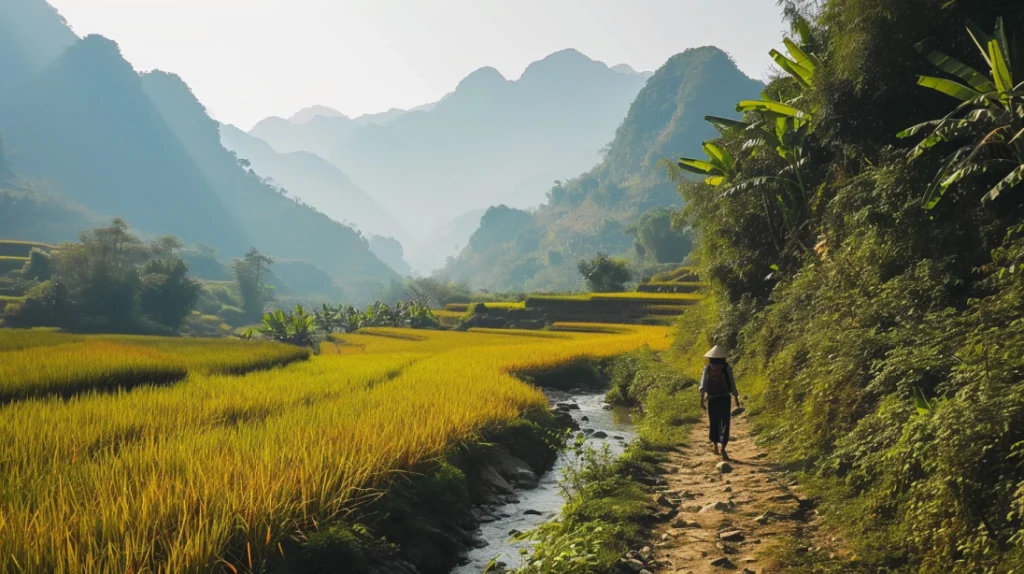G’day mate! Welcome to the ultimate travel guide to Vietnam, where we’ll uncover the ins and outs of this vibrant destination in the heart of Southeast Asia. Whether you’re keen on exploring bustling cities, diving into rich cultural experiences, or venturing through stunning natural landscapes, Vietnam has something for everyone. So, grab a cold one and let’s unravel the tapestry of this bonza country together!
How many days in Vietnam is enough?
A ten-day journey through Vietnam is a sweet spot for travellers keen to soak up the vibrant culture and diverse landscapes, from bustling southern metropolises to serene northern shores. It’s a comfortable stretch to enjoy the essential experiences, from sampling tantalising street food to cruising the emerald waters of Halong Bay. If you’re pressed for time, a shorter trip could still capture the spirit of Vietnam, but to truly appreciate the tapestry of tradition and natural beauty, those extra days can make a world of difference.
Should I visit Hanoi or Ho Chi Minh City?
If you’re up for a thrilling day out with hair-raising rides, then Ho Chi Minh City’s theme parks are your go. It’s a hotspot for some ripper rollercoasters. On the flip side, if your idea of a perfect arvo is wandering through galleries, soaking up both classical and modern art, then you’ll find Hanoi to be your cup of tea. It’s renowned for its cultural vibes and a top pick for art lovers. So, depending on whether you’re seeking an adrenaline fix or an artistic escape, your choice between Hanoi and Ho Chi Minh City is pretty clear-cut.
Which is better Bali or Vietnam?
Choosing between Bali and Vietnam comes down to what you’re seeking on your travels. If your journey is driven by a desire to browse through varied markets and bring home unique finds, Vietnam’s bustling bazaars and street markets will satisfy your shopping cravings. On the other hand, Bali, with its picturesque beaches and serene rice terraces, tends to attract a higher volume of holidaymakers each year, promising a tropical getaway unlike any other.
For those keen on exploring rich landscapes and cultural experiences, Vietnam is a treasure trove, offering everything from the limestone karsts of Ha Long Bay to the historic charm of Hoi An. It’s a haven for culinary explorers, with street food scenes that tantalise the taste buds and present a tapestry of local flavours.
In essence, both destinations boast their unique allure, be it Bali’s inviting coastlines and spiritual aura or Vietnam’s dynamic cities and cultural depth. The choice ultimately hinges on the type of adventure you wish to embark on during your holiday.

Which month is best to visit Vietnam?
For an ideal jaunt to Vietnam, aim for spring (March to April) or autumn (September to November) in the northern regions, promising warm, sunny days perfect for exploration. The summer stretch from May to August tends to be sweltering and sticky, less comfortable for sightseeing.
What injections do I need for Vietnam?
Before setting off on your journey to the captivating landscapes of Vietnam, it’s crucial to ensure your health is protected. Most adventurers venturing into this Southeast Asian haven should consider being vaccinated against diphtheria, tetanus, hepatitis A, and typhoid, as these are the primary injections recommended for travellers. Depending on your itinerary—whether you’re trekking through the lush highlands or engaging with local communities—additional vaccinations such as cholera, hepatitis B, Japanese encephalitis, and rabies might be necessary to keep you safe and healthy throughout your voyage. Always consult with a healthcare professional for the most up-to-date health advice before you immerse yourself in the rich culture and heritage of Vietnam.
Do I need a visa for Vietnam?
Sure, you might need a visa for Vietnam depending on your passport. The country issues e-visas for travellers from all nations and territories, allowing stays of up to 90 days with the flexibility of multiple entries. However, if you’re from one of the 13 countries that have a unilateral visa exemption agreement with Vietnam, you’re in luck because you can explore its captivating landscapes and vibrant cities without a visa for up to 45 days. Make sure to check the latest entry requirements before your journey.
What is the most expensive month to visit Vietnam?
Visiting Vietnam during December and January typically costs a traveller more dosh, mate. This peak period aligns with festive celebrations like Christmas, New Year’s, and the traditional Tet holiday, drawing crowds from near and far eager to soak in the vibrant culture and celebrations. So, if you’re planning a getaway during this bustling season, be prepared to fork out a bit more for the experience. Cheers!
What is the best way to travel in Vietnam for tourists?
For tourists keen to soak in Vietnam’s vibrant landscapes, taking to the roads in cars or buses is budget-friendly and offers a chance to truly embrace the local atmosphere. Keen explorers and road-trippers will find this option quite appealing. However, for covering the vast expanses across this breathtaking country, hopping on a plane or settling into a train carriage is your best bet.
These modes of transport strike the right balance between efficiency and the opportunity to witness the diverse scenery unfold—from the misty highlands to the lush deltas. Whether you’re journeying from the bustling streets of Ho Chi Minh City to the ancient charms of Hanoi, ensure your Vietnam expedition is both seamless and memorable by choosing the most suitable travel mode for your adventure.
What is the No 1 tourist spot in Vietnam?
Halong Bay stands out as Vietnam’s premier holiday destination, captivating visitors with its UNESCO World Heritage-listed seascape. Here, you’re treated to a visual feast of verdant limestone outcrops rising from the jade-green waters, a sight that truly defines the essence of travel in this vibrant country. Whether you’re cruising on a traditional junk boat or kayaking between the karsts, it’s an experience that encapsulates the adventure and natural beauty at the heart of Vietnamese tourism.
Is Vietnam an expensive trip?
Exploring Vietnam’s diverse landscapes can be affordable; your airfare might range from a modest $500 to a more premium $1,500. Once on Vietnamese soil, the price spectrum for digs spans from cozy backpacker joints at about $10 a night to opulent stays costing upwards of $200. So, whether you’re pinching pennies or splashing out, a Viet adventure can cater to your wallet’s whims.
Can you tour Vietnam on your own?
Absolutely, you can embark on a self-guided tour of Vietnam and experience the wonders this vibrant country has to offer. Key destinations like the bustling streets of Hanoi, the stunning vistas at Ha Long Bay, the ancestral charm of Hoi An, the dynamic vibes of Ho Chi Minh City, and the verdant scenes in the Mekong Delta are all accessible for solo travellers. Don’t miss out on the historical treasures of Hue, relax at seaside spots like Nha Trang and Mui Ne, or explore the majestic mountains around Sapa. With friendly locals and a well-trodden backpacker circuit, you’ll have no dramas finding your way around and soaking up the culture.
How much money is required for Vietnam trip?
For a journey to Vietnam, budget-savvy travellers from India might spend between INR 40,000 and 60,000 each, covering basics like accommodations, street food, and public transport over a 10-day itinerary. Those seeking more comfort – including superior accommodation, dining, and perhaps a few domestic flights – would likely find themselves parting with about INR 60,000 to 80,000 per person.
For those looking to indulge in luxurious stays, gourmet meals, and private tours, the expenditure can soar to INR 1,00,000 or more. Plan accordingly and consider the diverse experiences the Vietnam excursion offers, from bustling city walks to tranquil beachside retreats.
How much is an average meal in Vietnam?
An average meal in Vietnam will typically set you back between 50,000 VND to 200,000 VND. Whether you fancy dining at a snug local eatery or you’re keen to experience the fare at a more swish venue, you’ll find the costs quite reasonable, mate. This destination is a haven for those seeking a culinary adventure without the hefty price tag, incredibly appealing for travellers on the lookout for a budget-friendly gastronomic journey.
Is Vietnam or Thailand cheaper?
G’day! If you’re weighing up the cost between Vietnam and Thailand for a getaway, you’ll usually find your dollars stretch further in Vietnam. She’s a real bargain, with everything from digs, tucker to getting about often costing less than what you’d fork out in Thailand. Whether you’re exploring bustling cities, serene countryside, or stunning coastal spots in Vietnam, your wallet won’t be hit as hard, making it a bonza choice for travellers looking to save a few quid. Plus, you’ll experience the rich tapestry of Vietnam’s culture and landscapes, which makes it an ace option for an affordable adventure in Southeast Asia.
Is alcohol cheap in Vietnam?
Absolutely, booze is quite a bargain in Vietnam, mate. If you’re partial to a cold beer, you’re in for a treat—local brews are famously pocket-friendly. But, if you’re a wine aficionado, remember that vino’s a bit pricier since it’s not local tipple, so grabbing some duty-free on your way in is a smart move. Expect to shell out less than ten bucks for a decent imported bottle to savor with your pho. Cheers!
Conclusion
In essence, Vietnam is an incredible treasure trove, waiting to be explored at a comfortable pace. Whether you’re seeking thrilling adventures or a leisurely cultural escape, the country offers a rich tapestry of experiences. From finding your perfect spot between Hanoi and Ho Chi Minh City to understanding the ideal months for your travels, Vietnam promises diverse landscapes and vibrant cities to satiate the wanderlust in you. If you’re considering an escape that’s rich in history, culture, and natural beauty at an affordable cost, look no further than Vietnam – truly a bonza choice for your next getaway.


Stay connected